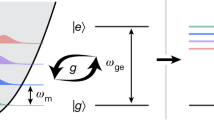Abstract
The mechanical detection of charge has a long history, dating back more than 200 years to Coulomb's torsion-balance electrometer1. The modern analogues of such instruments are semiconductor-based field-effect devices, the most sensitive of which are cryogenically cooled single-electron transistors2. But although these latter devices have extremely high charge sensitivity, they suffer from limited bandwidth and must be operated at millikelvin temperatures in order to reduce thermal noise. Here we report the fabrication and characterization of a working nanometre-scale mechanical electrometer. We achieve a charge sensitivity of 0.1 e Hz−0.5, competitive with conventional semiconductor field-effect transistors; moreover, thermal noise analysis indicates that the nanometre-scale electrometer should ultimately reach sensitivities of the order of 10−6 e Hz−0.5, comparable with charge-detection capabilities of cryogenic single-electron transistors. The nanometre-scale electrometer has the additional advantages of high temperature (⩾4.2 K) operation and response over a larger bandwidth, from which a diversity of applications may result.
This is a preview of subscription content, access via your institution
Access options
Subscribe to this journal
Receive 51 print issues and online access
$199.00 per year
only $3.90 per issue
Buy this article
- Purchase on Springer Link
- Instant access to full article PDF
Prices may be subject to local taxes which are calculated during checkout




Similar content being viewed by others
References
Coulomb, C. A. Memoires de l'Academie Royale des Sciences 229–236 (Academie royale des sciences, Paris, (1784).
Zimmerli, G., Eiles, T. M., Kautz, R. L. & Martinis, J. M. Noise in the Coulomb blockade electrometer. Appl. Phys. Lett. 61, 237–239 (1992).
Cleland, A. N. & Roukes, M. L. Fabrication of high frequency nanometer scale mechanical resonators from bulk Si crystals. Appl. Phys. Lett. 69, 2653–2655 (1996).
Albrecht, T. R., Grutter, P., Horne, D. & Rugar, D. Frequency modulation detection using high-Q cantilevers for enhanced force microscope sensitivity. J. Appl. Phys. 69, 668–673 (1991).
Robins, W. P. Phase Noise in Signal Sources: Theory and Applications (Peregrinus, London, (1984)).
Greywall, D. S., Yurke, B., Busch, P. A., Pargellis, A. N. & Willett, R. L. Evading amplifier noise in nonlinear oscillators. Phys. Rev. Lett. 72, 2992–2995 (1994).
Yurke, B., Greywall, D. S., Pargellis, A. N. & Busch, P. A. Theory of amplifier noise evasion in an oscillator employing a nonlinear resonator. Phys. Rev. A 51, 4211–4229 (1995).
Bordoni, F., Maggi, G., Ottaviano, A. & Pallotino, G. V. Very low noise cooled audiofrequency preamplifier for gravitational research. Rev. Sci. Instrum. 52, 1079–1086 (1981).
Stern, J. E., Terris, B. D., Mamin, H. J. & Rugar, D. Deposition and imaging of localized charge in insulator surfaces using a force microscope. Appl. Phys. Lett. 53, 2717–2719 (1988).
Schonenberger, C. & Alvarado, S. F. Observation of single charge carriers by force microscopy. Phys. Rev. Lett. 65, 3162–3164 (1990).
Pendry, J. B., Kirkman, P. D. & Castano, E. Electrons at disordered surfaces and 1/f noise. Phys. Rev. Lett. 57, 2983–2986 (1986).
Cleland, A. N., Esteve, D., Urbina, C. & Devoret, M. H. Very low noise photodector based on the single electron transistor. Appl. Phys. Lett. 61, 2820–2822 (1992).
Yoo, M. J. et al. Scanning single-electron transistor microscopy: Imaging individual charges. Science 276, 579–582 (1997).
Acknowledgements
This work was supported by DARPA ETO/MEMS.
Author information
Authors and Affiliations
Corresponding author
Rights and permissions
About this article
Cite this article
Cleland, A., Roukes, M. A nanometre-scale mechanical electrometer. Nature 392, 160–162 (1998). https://doi.org/10.1038/32373
Received:
Accepted:
Issue Date:
DOI: https://doi.org/10.1038/32373
This article is cited by
-
Higher-order singularities in phase-tracked electromechanical oscillators
Nature Communications (2023)
-
Fundamental limits and optimal estimation of the resonance frequency of a linear harmonic oscillator
Communications Physics (2021)
-
Amplifying the response of a driven resonator via nonlinear interaction with a secondary resonator
Nonlinear Dynamics (2021)
-
Estimating the effective quality factor of a rotary comb-drive microresonator based on a non-classical theory
Microsystem Technologies (2021)
-
Phase-delay induced variation of synchronization bandwidth and frequency stability in a micromechanical oscillator
Nonlinear Dynamics (2021)
Comments
By submitting a comment you agree to abide by our Terms and Community Guidelines. If you find something abusive or that does not comply with our terms or guidelines please flag it as inappropriate.



